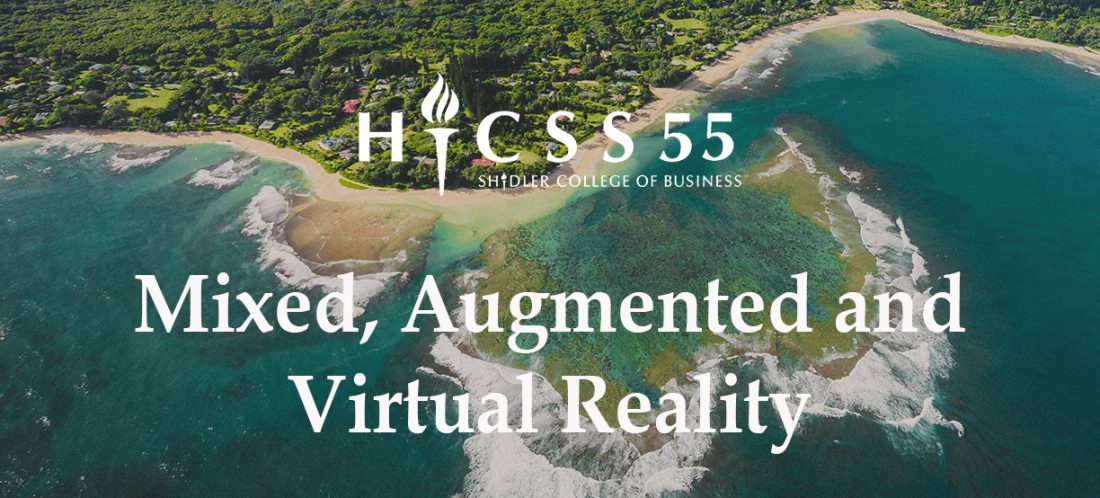
CALL FOR PAPERS: “MIXED, AUGMENTED AND VIRTUAL REALITY: SERVICES AND APPLICATIONS” AT THE 55TH HAWAII INTERNATIONAL CONFERENCE ON SYSTEM SCIENCES

INVITATION TO SUBMIT ARTICLES TO MINITRACK: “MIXED, AUGMENTED AND VIRTUAL REALITY: SERVICES AND APPLICATIONS” | 55TH ANNUAL HAWAII INTERNATIONAL CONFERENCE ON SYSTEM SCIENCES (HICSS 2022) | TRACK: “Decision Analytics and Service Science” | 55TH annual Hawaii International Conference on System Sciences HICSS: January 4-7, 2022 @ Grand Hyatt, Kauai, Hawaii
===
Virtual reality (VR), augmented reality (AR), mixed reality (MR) and related immersive visualization technologies are increasingly used in retailing, education and tourism (Loureiro et al., 2019). Together these technologies are expected to disturb existing markets like PCs and smartphones did when they were introduced (Goldman Sachs, 2016). Firms are encouraged to develop strategies on how to design and integrate these technologies with their businesses (Porter and Heppelmann, 2017). The first wave of VR came already in 1990’s when a number of industries were inspired by VR games (Botella et al., 1998; Wiederhold and Wiederhold, 1998; Jayaram et al., 1999). However, the user experience was still unpleasant and the hype soon passed. After 2005, a second wave of VR emerged and was more successfully employed in different fields such as engineering, medicine, mental health, design, architecture and construction, education, arts, entertainment, business, advertising, military and travel (Saggio and Ferrari, 2012; Zyda, 2005; Jayaram et al., 1999; Smyth, 2005; Huges et al., 2013). At the moment, device, component, software and user-interface development is going globally fast forward and many world-leading companies are adopting these technologies (Porter and Heppelmann, 2017).
Current academic research with regards to VR, AR and MR technologies has mainly concentrated on the technology itself. Thus, there is a research gap in studying user experiences, decision-making and technology development side-by-side in order to understand the value-in-use these technologies create. The key value drivers for users are, for example, cost-saving through out-of-home and out-ofoffice access, total control and high level of personalization, going beyond reality, personal efficacy experiences, feeling of safety, privacy and confidentiality and immersive experiences (Botella et al., 1998; 2004; Côté and Bouchard, 2005; Gorini and Riva, 2008; Repetto and Riva, 2011; Riva, 2005; Riva et al., 2004; Wiederhold and Wiederhold, 1998; Zimand et al., 2003). During the pandemic, these utilities have become even more important and demand on these technologies have been increasing (Singh et al. 2020).
From this point of view, the major challenge for VR, AR and MR technologies is to convince not only customers but also service personnel with the value proposition that are additional and high enough to compete with the current systems and offerings available in desktops, tablets, smartphones and video and game-like applications. The minitrack will concentrate on showcasing research on technology and application development with specific orientation towards user experience and behaviour. Interesting research avenues are, for example, user decision-making, customer value and service design. Customer value-guided development of the technologies and consequent innovative business models are some of the expected outcomes. As HICSS addresses cutting edge interdisciplinary developments, we encourage submissions from both technology and business development perspectives.
Fields of research that can contribute to the minitrack include computer science, information systems science, e-commerce, decision-making or any scholarly or industry field developing MR, AR and VR applications. We welcome contributions from all contexts and industries. Previously, there has been an emphasis on healthcare, e-commerce, travel, sports, education and industrial solutions, but new areas are welcome as well. We seek empirical and conceptual research papers, methodological papers, quantitative analyses, case studies, reviews and practitioner reports. In addition to the regular HICSS criteria, the degree of novelty in both the technology employed and innovativeness of the application is given considerable weight in the evaluation of the papers.
===
We welcome all entries related to:
- Virtual reality
- Augmented reality
- Mixed reality
- Immersive technologies
In the context of services, products, business, economy, psychology, computer science, computer graphics, geomatics, land-use, urban science, human-computer interaction and analytics.
The example approaches of success and failure of adopting these technologies:
o User decision-making, satisfaction, flow, immersion
o User value, efficiency and operative benefits
o Human resource development, e.g. learning, training, education tutorials, personnel
motivation
o Sales, marketing and e-commerce applications
o Wellness and the experience economy
o Usability, user experience and user interface development
o Content creation methodologies, tools and approaches, e.g. capturing and recording reality
(laser scanning, photogrammetry, using drones), animation and modelling, motion tracking,
and utilizing artificial intelligence in modelling and interactions
The topic in earlier HICSS conferences, proceedings and special issue:
The topic has grown significantly over the past four HICSS conferences beginning from the HICSS-49 Keynote Address. One of the aims of the minitrack is to fortify the interdisciplinary angle to the topics at the IS-CS-marketing intersection and gather momentum. The presented papers will be published in the proceedings of the 49th Hawaii International Conference on System Sciences. In addition, the chairs will look into the possibility of creating a special issue around the topic in a suited journal (e.g. in Electronic Commerce Research and Applications).
===
TRACK CHAIRS
Jani Holopainen (Primary)
University of Jyväskylä, Finland
Tel: +358 50 376 6392
Email: jani.m.holopainen@jyu.fi
Osmo Mattila
University of Helsinki, Finland
Tel. +358 44 030 8177
Email: osmo.mattila@helsinki.fi
Essi Pöyry
University of Helsinki, Finland
Tel: +358 50 322 3298
Email: essi.poyry@helsinki.fi
Juho Hamari
Tampere University, Finland
Tel: +358 40 835 9563
Email: juho.hamari@tuni.fi




Sorry, the comment form is closed at this time.